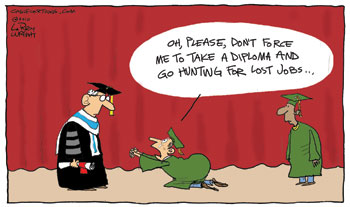
The one thing that economists seem to agree on is that any economic recovery will be an uphill battle for some time to come. But if you’ve ever pulled a heavy wagon up a hill, you know what happens if your fellow pullers decide to become riders instead and jump on the wagon.
That is what has been happening, and the results should surprise no one. The jobs report on June 4 by the U.S. Bureau of Labor Statistics was anything but encouraging. In fact, the BLS Employment Situation Summary for May paints a very depressing picture, despite the government’s attempt to put a happy face on it. “Total nonfarm payroll employment grew by 431,000 in May,” begins the opening sentence of the BLS summary. Hurray! 431,000 new jobs! But, in part two of the same sentence we learn that the employment boost statistics reflect “the hiring of 411,000 temporary employees to work on Census 2010.” The second sentence of the BLS monthly summary reveals the truly bleak facts: “Private-sector employment changed little (+41,000).” Yes, new Fedgov jobs increased by more than ten times the number of new private sector jobs.
“Paychecks from private business shrank to their smallest share of personal income in U.S. history during the first quarter of this year,” according to an analysis of government data by USA Today, which the paper reported on May 26. “At the same time,” noted the USA Today article, “government-provided benefits — from Social Security, unemployment insurance, food stamps and other programs — rose to a record high during the first three months of 2010. Those records reflect a long-term trend accelerated by the recession and the federal stimulus program…. The result is a major shift in the source of personal income from private wages to government programs.”
The USA Today report goes on to note: “A record-low 41.9% of the nation’s personal income came from private wages and salaries in the first quarter, down from 44.6% when the recession began in December 2007.” This trend will only accelerate as the ObamaCare takeover of health and medicine gets underway. And, of course, that does not end the plans for ever-expanding government. The initial Obama “stimulus plan” having obviously failed, the White House is now touting plans for a new $50 billion federal bailout for state and local governments.
 President Obama, the New York Times reported on June 12, has sent a letter to Democratic and Republican congressional leaders asking for additional aid to stem “the devastating economic impact of budget cuts” by local governments.
President Obama, the New York Times reported on June 12, has sent a letter to Democratic and Republican congressional leaders asking for additional aid to stem “the devastating economic impact of budget cuts” by local governments.
Although BLS figures show that state and local governments did shed a few thousand jobs during May, overall they have been unwilling to make the cuts needed to stave off the looming economic catastrophe of default and bankruptcy.
California is a prime example of the state profligacy that competes with the feds. The California legislature is proposing a fiscal 2011 budget with a $19.1 billion deficit — to be piled on top of the state’s already gigantic $69 billion in outstanding debt.
While the recession has caused virtually every private business to face economic realities by tightening belts, cutting spending, and laying off employees, most state and local governments have followed the example of Big Brother in Washington.
In a May 10, 2010 analysis for the Reason Foundation, Adam Summers writes regarding California state government: “Incredibly, the state has added over 13,000 employees since the onset of the economic recession in 2008 and continued hiring even during the worst of the recession…. Between June 2008 and January 31, 2009, most state agencies either maintained or increased the number of full-time employees, resulting in a net increase of over 2,000 workers.”
It’s not just that governments have been hiring more and more; they’ve also been paying higher and higher salaries — far higher than their private sector counterparts for comparable jobs. Adam Summers reports that according to Bureau of Labor Statistics data, “as of December 2009, state and local government employees earned total compensation of $39.60 an hour, compared to $27.42 an hour for private industry workers — a difference of over 44 percent.” Summers reports that “the average annual salary of a California state government employee was $53,958, nearly 32 percent greater than the average private sector worker ($40,991).”
But the real plum gigs are Fedgov jobs. “Federal employees earn higher average salaries than private-sector workers in more than eight out of 10 occupations,” according to a USA Today analysis of the latest available federal data. Overall, federal workers earned an average salary of $67,691 in 2008, compared to an average pay of $60,046 for the same mix of jobs in the private sector. When the recession started, the Transportation Department had only one person earning a salary of $170,000 or more, but 18 months later, nearly 1,700 employees had salaries above $170,000. This trend to six-figure salaries extends across the entire federal bureaucracy.
The pullers had better kick a lot of these riders off the wagon real soon, or we’re all going to slide backward into the abyss together.



